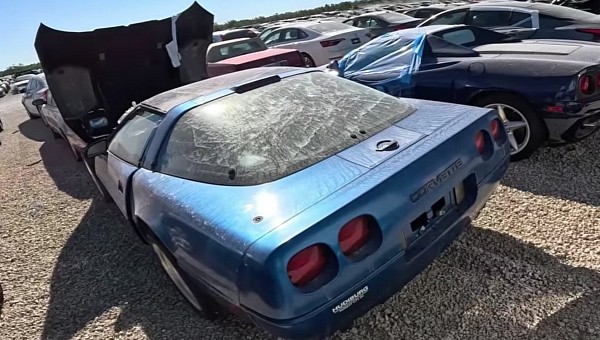They say water is life, but when it comes to internal combustion engines, cooling is as far as it can get. It is for the same reason flood-damaged cars almost always get sent to the crushers. Unless, of course, it’s a high-value car with the potential of getting flipped for a few bucks.
Last year, America witnessed the devastating effects of Hurricane Ian. In the automotive industry, that only means one thing – an influx of flood-damaged cars in the used car market.
Sam of the Samcrac YouTube channel recently got his hands on a salt-water flooded 1991 Chevrolet Corvette ZR1.
To remind you, the 1991 Corvette ZR1, a.k.a the ‘The King of the Hill,’ will go down in history as one of the fastest cars of its time. It was officially launched in 1984 and came with a 350 cubic-inch 5.7-liter engine configurable to several outputs. For instance, the LT5 V8 dropped in the C4 ZR1 was good for 375 hp (380 ps).
Sam got this fantastic time capsule for $8,000, a bargain considering the cheapest ones on the market go for about $20,000 on sites like Bring a Trailer.
Besides the glaring salt-water flooded history, this C4 Corvette unit had a couple of issues. It came with a branded title, no odometer reading, zero service history, and, more worryingly – no keys.
If you know anything about Corvettes of this era, GM fitted a factory immobilizer better known as the VAT (Vehicle Anti-theft). Don’t get me wrong, a 39-year-old antitheft system isn’t anything to worry about in 2023, even for a two-time hacker, but it’s an added hurdle to an uncertain revival.
On the bright side, the time capsule had no water damage on the interior. There was no visible sign of mold or water-damaged fittings.
ICEs are designed to run on gasoline, diesel, CNG, LPG, and in some rare cases, hydrogen. Therefore, if a combustion engine takes a dip in salt water, there’s a good chance it’s a goner.
Sam is a sucker for cheap DIY builds, on his latest upload, he took it upon himself to get this time capsule back up and running.
The bad news is there was more water than oil when the oil pan plug was removed. The good news is there was no sign of corrosion on the engine's top end.
Besides bypassing the VAT system and cleaning out the oil pan and windage tray, he had to buy a couple of replacement parts, including the oil pan gasket (with an O-ring), a refurbished C4 ZR1 starter, fuel filter, and a new set of ignition coils.
Luckily, the fuel in the tank was good (it did not mix with salt water).
The 1991 C4 ZR1 engine ran on the second attempt. He still had to service the transmission and rear differential, and fortunately, on the next episode, we’ll see him drive it out of his garage.
“We are in a really good spot right now. We just need a few more things to get this car on the ground and make it drive under its own power.” Sam revealed.
We recommend watching the video below. It's an excellent place to start if you plan to revive a flooded classic car.
Sam of the Samcrac YouTube channel recently got his hands on a salt-water flooded 1991 Chevrolet Corvette ZR1.
To remind you, the 1991 Corvette ZR1, a.k.a the ‘The King of the Hill,’ will go down in history as one of the fastest cars of its time. It was officially launched in 1984 and came with a 350 cubic-inch 5.7-liter engine configurable to several outputs. For instance, the LT5 V8 dropped in the C4 ZR1 was good for 375 hp (380 ps).
Sam got this fantastic time capsule for $8,000, a bargain considering the cheapest ones on the market go for about $20,000 on sites like Bring a Trailer.
Besides the glaring salt-water flooded history, this C4 Corvette unit had a couple of issues. It came with a branded title, no odometer reading, zero service history, and, more worryingly – no keys.
If you know anything about Corvettes of this era, GM fitted a factory immobilizer better known as the VAT (Vehicle Anti-theft). Don’t get me wrong, a 39-year-old antitheft system isn’t anything to worry about in 2023, even for a two-time hacker, but it’s an added hurdle to an uncertain revival.
On the bright side, the time capsule had no water damage on the interior. There was no visible sign of mold or water-damaged fittings.
ICEs are designed to run on gasoline, diesel, CNG, LPG, and in some rare cases, hydrogen. Therefore, if a combustion engine takes a dip in salt water, there’s a good chance it’s a goner.
Sam is a sucker for cheap DIY builds, on his latest upload, he took it upon himself to get this time capsule back up and running.
The bad news is there was more water than oil when the oil pan plug was removed. The good news is there was no sign of corrosion on the engine's top end.
Besides bypassing the VAT system and cleaning out the oil pan and windage tray, he had to buy a couple of replacement parts, including the oil pan gasket (with an O-ring), a refurbished C4 ZR1 starter, fuel filter, and a new set of ignition coils.
Luckily, the fuel in the tank was good (it did not mix with salt water).
The 1991 C4 ZR1 engine ran on the second attempt. He still had to service the transmission and rear differential, and fortunately, on the next episode, we’ll see him drive it out of his garage.
“We are in a really good spot right now. We just need a few more things to get this car on the ground and make it drive under its own power.” Sam revealed.
We recommend watching the video below. It's an excellent place to start if you plan to revive a flooded classic car.












